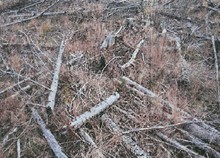Fire Hazards Exist in Cut Blocks
By 250 News
In a study of recently logged areas, the Forest Practices Board found that fire hazard was reduced satisfactorily in most cases, but no licensees fully met the legal requirement to assess fire hazard as required by the Wildfire Act.
The study examined 111 randomly selected cutblocks, harvested from 2005 - 2007, in the Central-Cariboo and Okanagan-Shuswap forest districts.
The Wildfire Act requires licensees to assess fuel hazard and the risk of a fire starting as well as spreading, and to abate the fire hazard if necessary.
In many cases, licensees assessed the fuel hazard, but in no case did they assess the risk of a fire starting or spreading. Despite the lack of compliance, fire hazards were often abated by routine practices such as piling and burning slash and debris at the roadside.
( at right, debris left at the site where trees were processed at the stump)
"While results were generally good, we are concerned that some licensees are not recognizing high-risk situations, such as when trees are processed at the stump, increasing the fire hazard due to large amounts of slash left on the site," said board chair Bruce Fraser.
The report makes three recommendations for improvement to fire hazard assessment and abatement practices.
The Board recommends that:
The Association of BC Forest Professionals has agreed to work with government and industry to address the recommendations.
Previous Story - Next Story
Return to Home








